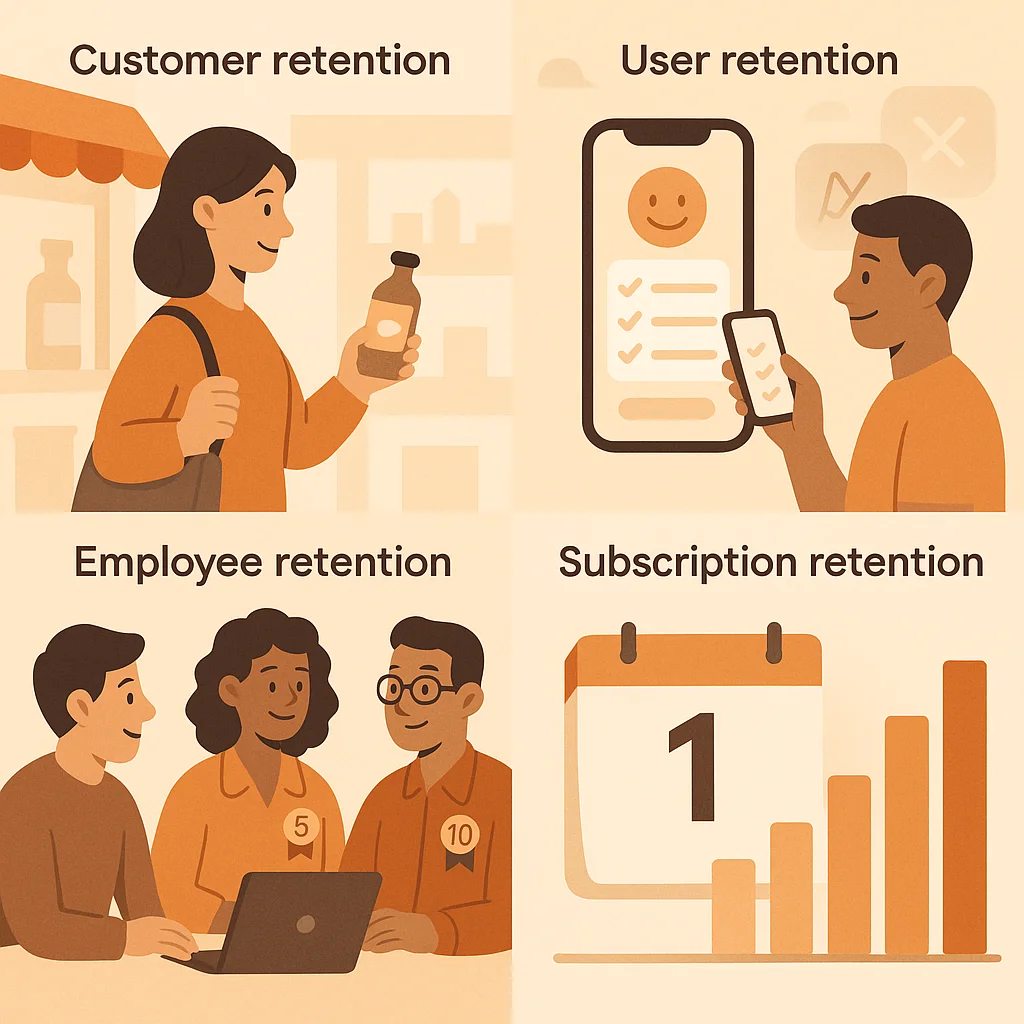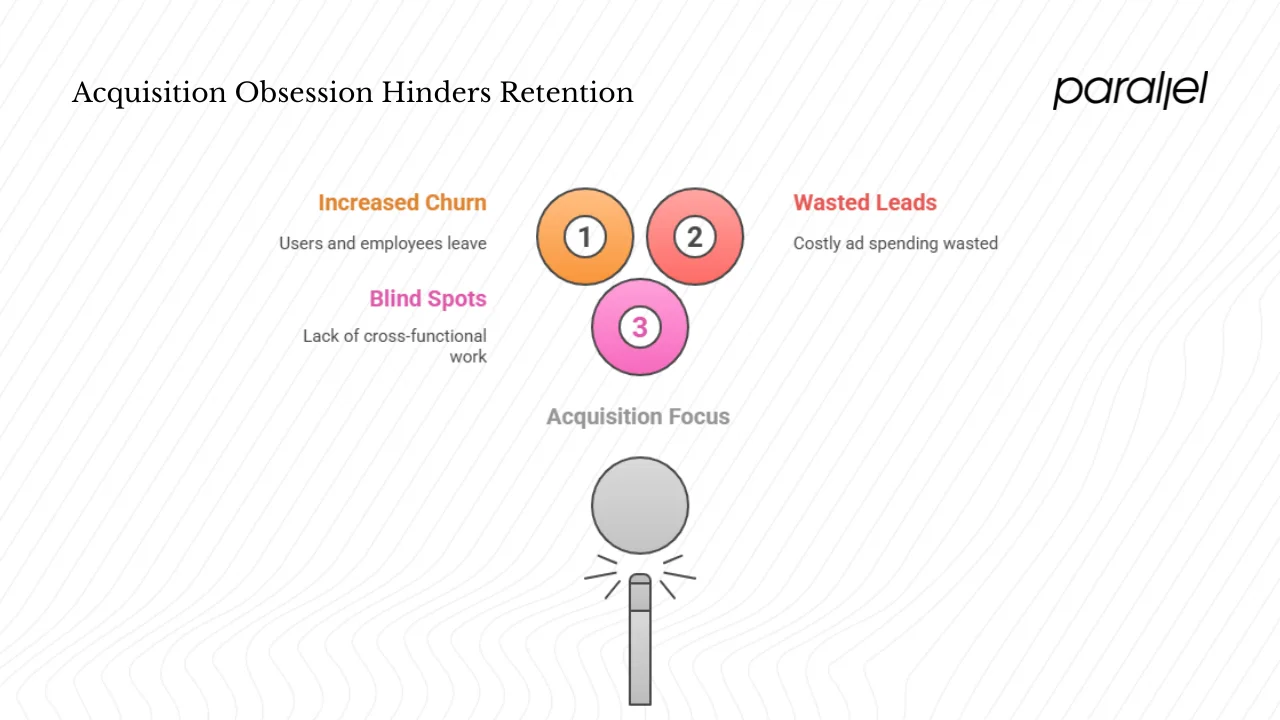What Is Retention? In-depth Guide (2025)
Understand retention as a metric across business and marketing contexts and strategies to maintain customer engagement.

Early‑stage founders and product leaders often focus on chasing sign‑ups. The better question is: what is retention? This article explores what retention means for customers, users, employees and subscriptions, explains how to measure it, and shares ways to improve it using insights from 2024‑25 research and our experience with early‑stage teams.
What is retention? – core definitions
In everyday language “retention” means the ability to keep something rather than losing it. In business it takes on several flavours. Appier describes retention as a company’s ability to maintain connections with its customers, users or employees over time. In other words, it’s about persuading people to stay instead of switching to a rival. When we ask what is retention for a business, we’re talking about the percentage of customers, users or staff who stick with us from one period to the next. That simple concept branches into several contexts:
- Customer or client retention: keeping customers coming back and choosing your brand instead of a competitor. This is often called brand loyalty. High retention rates usually reflect a positive customer experience; research shows people with positive past experiences spend 140% more than those with poor experiences.
- User retention: for software and SaaS products it’s the share of users who keep logging in and engaging over time. This is closely tied to onboarding and habit building. A study cited by Nielsen Norman Group found that 70% of people abandon applications because they’re hard to use. If your onboarding is clunky, your retention curve will drop quickly.
- Employee retention: your ability to keep employees in their roles and reduce turnover. Gallup’s research shows companies with high retention enjoy a 22% rise in overall profitability and workplaces with strong engagement see a 24% drop in turnover.
- Data retention and subscription renewal: in a subscription business you care about how many subscribers renew; data retention also matters when you need to preserve information for compliance or analytics. RevenueCat’s 2025 report says that the first renewal has the biggest impact, with churn rates of 30‑50% for weekly plans and 15‑40% for monthly plans. Annual subscriptions, however, have renewal rates above 85%.

These definitions share a single thread: retention means keeping something valuable. Whether you’re talking about customers, users, staff or subscriptions, the idea boils down to the proportion of the base that stays with you over time.
Why retention matters for startups and product teams
Acquiring new customers costs between five and twenty‑five times more than keeping an existing one. When you ask yourself what is retention, think about holding on to people rather than constantly replacing them. Even a 5% lift in customer retention can boost profits by 25–95%. Loyal customers spend about 140% more than those with poor experiences and often bring in friends, which multiplies growth.
Retention also signals product–market fit. If your retention curve crashes, onboarding or the product promise needs work. High employee retention matters too—replacing a person can cost up to twice their salary. Subscription businesses must mind renewal schedules: weekly plans lose 30–50% of subscribers at the first renewal, monthly plans 15–40%, while annual plans keep more than 85%. From churn curves to payroll, retention affects every part of your business.
Important dimensions of retention
Retention isn’t monolithic; it comes in different flavours. To truly answer this question in practice, you need to understand these separate dimensions.

1) Customer retention and brand loyalty
Customers come back when they trust you. Media and professional services businesses hold on to about 84% of their customers, while hospitality and travel manage roughly 55%. Loyalty programmes, personalised offers and consistent service encourage repeat purchases. Good experiences drive spending; people with positive interactions spend about 140% more than those with bad ones. Metrics such as repeat purchase rate and customer lifetime value tell you how sticky your customer base is.
2) User retention and product lifespan
In software, retention measures how many users keep logging in after the first sign‑up. Retention curves show the percentage of users who return over time; the curve should flatten, not crash. Usability is critical: Nielsen Norman Group reports that 70% of users abandon apps when they’re hard to use. Onboarding that delivers value quickly helps build habits. Compare retention in the first week to retention in month three to see if you’re solving a lasting problem.
3) Employee retention and managing turnover
Replacing an employee can cost up to twice their salary. Yet early attrition is common: about 38% leave in the first year and 20% within the first 45 days. People stay when they see growth prospects, feel supported and are fairly paid. High retention improves profitability and preserves institutional knowledge.
4) Data retention and subscription renewal
Data retention means keeping information accessible for operations and compliance. In subscription businesses, retention is about renewals. RevenueCat’s 2025 report shows that weekly plans lose 30–50% of subscribers at the first renewal, while monthly plans lose 15–40%. Annual plans keep more than 85%, and low‑priced subscriptions retain about 79% by the third renewal. Price and plan length shape whether people keep paying.
How to measure retention
Retention tells you how many people from a starting group are still with you after a set period. You decide who that group is before you start measuring. That could be customers, subscribers, employees, or product users. The method is the same across all of them: define the starting pool, track who’s left at the end, and compare the two.
Core customer retention formula
A simple way to track customers is:
- Count how many customers you had at the start.
- Count how many you have at the end.
- Subtract any new customers who joined during that window.
- Divide what remains by your starting count.
This gives you a clean picture of how well you held on to people you already had.
SaaS: using cohorts and retention curves
SaaS teams often want week-by-week or month-by-month views. Two tools help with that.
Cohort tables
- Group new users by their start date.
- Track how many of them show up again in each later period.
- Compare how different cohorts behave to spot product issues or improvements.
Retention curves
- Plot what share of each cohort returns over time.
- Watch the shape of the curve. A fast drop shows early friction. A flat tail shows a stable core that sticks around.
Employee retention
For teams, the math is more straightforward.
- Count how many employees you had at the start.
- Count how many are still employed at the end.
- Divide the remaining number by the starting count.
Because hiring and turnover vary a lot between roles, it helps to measure by team or job type, not just the company as a whole.
Subscription businesses
For subscription companies, two signals carry most of the weight.
Renewal rate
- The share of subscribers who choose to continue each cycle.
Churn
- The share who leave.
- Weekly plans can lose 30–50%.
- Monthly plans often fall in the 15–40% range.
Tracking both numbers tells you if the plan structure or value delivery is off.
Industry benchmarks
Retention differs widely by sector, so context matters.
- Media companies often reach about 84%.
- Retail sits closer to 63%.
These aren’t targets. They’re just reference points to help you judge your own trend.
Why segmentation matters
A single retention number hides the real problem spots. Break your groups down by:
- Acquisition channel
- Product or plan type
- User cohort
- Region or store
- Customer segment
This helps you spot where people slip away and where your strongest base lives.
Keep your baseline in view
Short-term spikes and dips will happen. What matters is whether your long-term line is rising, flat, or falling. Build your evaluation around that steady baseline, not one noisy month.
Why retention gets overlooked and what to watch out for
Many founders focus on acquisition because sign‑ups are visible and satisfying. That bias hides underlying churn. The common traps are:
- Acquisition obsession: pouring money into ads without nurturing existing customers. Acquisition costs have climbed by about 50% in recent years, so wasting new leads is costly.
- Broken onboarding: confusing sign‑ups and poor usability drive users and employees away. Seventy percent of people abandon difficult applications, and nearly 38% of workers quit in their first year when support is weak.
- Neglected renewals: subscriptions require early engagement. Weekly plans can lose up to half their subscribers at the first renewal when businesses fail to deliver ongoing value.

Retention requires cross‑functional work: product, design, engineering, support, people operations and finance all have roles to play. If one team owns it alone, blind spots appear.
Strategies to improve retention
You can’t improve retention unless you first understand what retention means for each audience you serve. Customers, users, staff and subscribers have different needs, but some themes recur.
Customer and user strategies
- Onboard well: guide new customers or users to their first win quickly. Poor onboarding is a major cause of churn.
- Personalise and reward: customise messages and offers; loyalty programmes and personalised offers encourage repeat purchases.
- Improve the experience: fix usability issues—70% of users abandon difficult apps—and keep features fresh.
Employee strategies
- Offer growth: invest in development; 94% of employees stay longer when they see a path forward.
- Support people: recognise contributions, avoid micromanagement and balance workloads.
- Pay and flexibility: compensate fairly and allow flexible working arrangements.
Subscription strategies
- Deliver value early: the first renewal is the biggest hurdle; weekly plans see 30–50% churn and monthly 15–40%.
- Pick sensible plan lengths: annual plans retain more than 85% of subscribers.
- Price appropriately: low‑priced subscriptions have better long‑term retention.
Running retention in a startup or product‑team context
In an early‑stage company, retention should sit next to acquisition and revenue on the dashboard. Build simple analytics from day one so you can see if users come back in week two or if customers renew in month one. Focus your roadmap on onboarding, activation and habit loops, and set concrete goals around those return moments. Don’t view retention as a marketing problem; product, design, engineering, support and HR all influence whether people stay. Use qualitative feedback and cohort data to iterate quickly, and keep in mind that sign‑ups mean little if they don’t stick around.
Common mistakes and myths about retention
Misunderstandings can hurt your retention efforts:
- More features won’t fix churn: piling on features doesn’t guarantee people will stay; complexity often makes products harder to use.
- Focusing only on sign‑ups: when you ignore existing customers or assume retention is solely marketing’s problem, you’ll bleed them faster than you add new ones; product, engineering, support and people operations all share responsibility.
- Headline metrics hide the story: cohort and segment analysis reveal where churn happens; raw averages don’t capture the underlying pattern.
Conclusion
Retention is the skill of keeping what you’ve worked so hard to gain. Whether you’re a founder chasing product–market fit, a product manager refining onboarding or an engineering leader building a team, you need to understand what is retention and why it matters. Retention is not a single metric but a set of practices that touch customers, users, employees and data. It saves money, drives growth, signals that your product solves real problems and preserves institutional knowledge. Industry benchmarks show that retention rates vary widely, from 84% in media and professional services to 55% in hospitality. Likewise, subscription plans and pricing have a huge influence on renewal rates. High employee retention correlates with higher profitability, while poor onboarding leads to early churn.
For founders and product leaders, the challenge is to pick one retention metric, dig into why people are leaving and make one change to improve it. Measure, learn and repeat. Good retention is built through thoughtful design, supportive environments and clear value. Keep asking yourself what is retention and how well you’re retaining people, and let those questions guide your product and team decisions.
FAQ
1) What is retention?
In plain language, retention means keeping something instead of losing it. In business contexts it refers to keeping customers, users, employees or data over time. The term is about ongoing connections rather than one‑off transactions.
2) What does retention mean for a job?
For a job, retention refers to an organisation’s ability to keep employees in their roles rather than seeing them leave. High retention correlates with higher profitability and lower recruitment costs. Poor retention often stems from inadequate onboarding, lack of growth opportunities and unsupportive environments.
3) What does retention mean in medical terms?
In medicine, retention often describes the abnormal holding of a fluid or secretion in a body cavity, such as urine retention or fluid retention. It’s a physiological term indicating that something that should be released or drained is instead being held.
4) What does retention mean in business?
In business, retention encompasses customer loyalty, user engagement, employee continuity and subscription renewal. It’s the measure of how many people or accounts stay with you over time. Asking what is retention in business forces you to look at whether you’re building lasting value or just chasing short‑term wins.


.avif)










